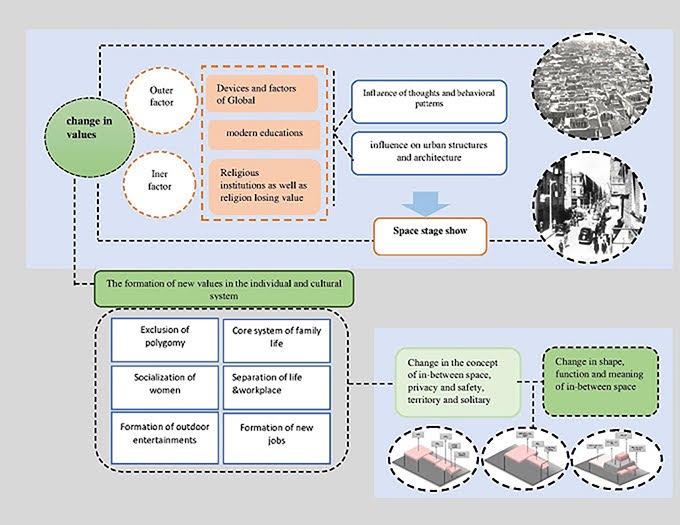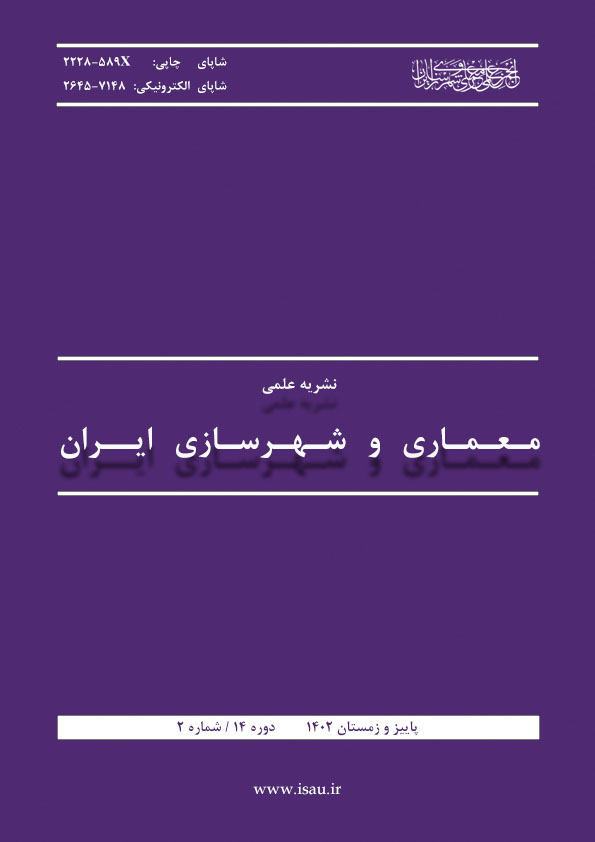نوع مقاله : مقاله پژوهشی
نویسندگان
1 دانشجوی دکتری معماری، گروه معماری، دانشکده معماری و شهرسازی، واحد تهران مرکزی، دانشگاه آزاد اسلامی، تهران، ایران.
2 استادیار، گروه معماری، دانشکده معماری و شهرسازی، واحد تهران مرکزی، دانشگاه آزاد اسلامی، تهران، ایران.
چکیده
هر فرهنگی، در هر دورهی زمانی الگوهایی از انسان ارائه میدهد که فعالیتها، موفقیتها و وظایف اجتماعی افراد را مشخص میکند. افراد جامعه در قالب این الگوها و ارزشها، طرح زندگی خود را میریزند و آن را زیست مینمایند. بنابراین الگوها و ارزشهای شکلگرفته در جوامع سنتی با توجه به تغییرات اجتماعی و انقلابهای رخ داده در جهان، تحت تاثیر قرار گرفته و دچار بازتعریف جدید میگردد. در این اتفاق ارزشهای جدید، جایگزین ارزشها و باورهایی میشوند که سالیان سال، افراد یک جامعه آن را زیسته و طبق آن محیط فیزیکی خود را شکل دادهاند. بنابراین طبق نظر جامعهشناسان و روانشناسان اجتماعی، تغییرات اجتماعی میتواند اثرات مادی و غیر مادی بر جوامع داشته باشد، بدین منظور این مقاله قصد دارد با پرداختن به تغییرات ارزشی که بعد غیرمادی تغییرات خوانده میشود، به اثرات مادی (کالبدی) که بر فضا (در این مقاله فضای میانی) میگذارد، پی ببرد. روش تحقیق در این پژوهش از نوع کیفی، و به لحاظ هدف، تاریخی- تفسیری و منطق تحقیق از نوع پسکاوی میباشد. نتایج تحقیق حاکی از آن است که با تغییر در ارزشهای جامعه در عصر قاجار و پهلوی اول، ارزشهای جدیدی جایگزین آن گشتهاند که سبب تغییر در مفاهیم شکلدهنده فضای میانی همچون، محرمیت و حریم، خلوت و قلمرو شده و به واسطه این اتفاق تغییرات وسیعی در شکل (کالبد)، کارکرد و معنای این فضاها به وجود آمده است.
چکیده تصویری
تازه های تحقیق
- دستاوردهای بهرهگیری از رویکرد «فضا صحنه» در تحلیلات فضای میانی، سبب میشود، به کلیه مسائل اجتماعی-فضایی و همچنین تعاملات و کنشهای انسانی توجه شود.
- نظریه جانسون، تعادل یک نظام اجتماعی را تابع درجۀ سازگاری بین ارزشهای یک جامعه و شرایط محیطی آن جامعه میداند. او منابع تغییر یک نظام اجتماعی متعادل را دو عامل تغییرارزش و محیط بیان میدارد.
- مهمترین مولفههای تغییردر ارزشها در جوامع طبق نظریه جانسون را میتوان، به نقش انقلابها در جوامع همسایه، کمرنگ شدن مذهب، آموزشهای جدید و اکتشافات و ابداعات جدید و دیگر موارد مطرح میباشند، که در دگرگونی ارزشهای فرهنگی و فردی افراد در عصر قاجار و پهلوی اول بسیار تاثیرگذار بودهاند.
کلیدواژهها
موضوعات
عنوان مقاله [English]
The development of in-between spaces in houses during Qajar and Pahlavi I period based on changes of value
نویسندگان [English]
- Paria Aliakbari 1
- Shadi Azizi 2
- Mozaien Dehbashi Sharif 2
1 Ph.D. Candidate in Architecture, Department of Architecture, Faculty of Architecture and Urbanism, Tehran Central Branch, Islamic Azad University, Tehran, Iran.
2 Assistant Professor, Department of Architecture, Faculty of Architecture and Urbanism, Tehran Central Branch, Islamic Azad University, Tehran, Iran.
چکیده [English]
Extended Abstract
Background and Objectives: Every culture provides human patterns in various time periods which determine activities, achievements and social responsibilities of people. These cultural patterns and values influence individuals’ lifestyles and guide their actions. Consequently, the formed values of traditional societies undergo transformation as global social changes and revolutions redefine societal norms. In this process, the values with which people lived their lives for years and then formed their physical environment are replaced with some new values and patterns. Therefore, it can be said that space matters in understanding the changes and social developments that have taken place in the society in the space-time dimension. In order to see the changes that have taken place in the society, one must pay attention to its physical appearance in order to understand the root of the transformation in the structures of the society. Architecture and the city can be considered as elements that are affected by the societal conditions, effectively illustrating and manifesting societal changes. One of the most important causes of spatial changes are the social changes. According to social psychologists and sociologists, social changes influence societies in both materialistic and non-materialistic aspects. This study aims to explore non-materialistic aspects, particularly changes of value, and their materialistic effects on spaces, focusing specifically on in-between spaces.
Methods: The methodology used in this study is qualitative in nature, with an exploratory-historical and post-analytical logic. The exploratory-historical logic explores historical contexts to understand societal mechanisms and approaches. Meanwhile, the post-analytical logic examines current societal mechanisms and approaches and constructs hypothetical models to explore underlying relationships. Data collection for this study involved gathering information from various sources, including bibliographic research, as well as primary and secondary resources such as images and documents.
Findings: Values of a society reveal the culture and beliefs of a nation which can directly impact the form and structure of its built environment. As a result, in-between spaces, as semi-public and semi-private spaces, carry several roles which are being affected by the values of their time. These values were transformed in Qajar period when the signs of modernity appeared in architecture. The findings highlight the emergence of new societal values, including socialization of women in society, rejection of polygamy among men, shrinking families (nuclear structure), separation between home and workplace, outburst of western goods (new appliances of life, formation of new entertainment out of home, emergence of service jobs, individualism and independent lifestyles). The aforementioned factors have changed in-between spaces through some structural changes, so they formed new values and have changed the notions of in-between spaces, such as privacy, private area and personal spaces. Consequently, new forms of in-between spaces, such as balconies, pause areas, and horizontal divisions like stairways, have emerged to accommodate these evolving societal values.
Conclusion: The reciprocal relationship between space and social changes is evident in the two studied periods. During the Qajar and Pahlavi I period, the construction of new spaces and buildings that were not seen before in Iranian society, led to significant physical changes that mirrored evolving societal values. On the other hand, cultural connections with the West, educational trips, travel and printing of books and newspapers and other factors led to major changes in individual and social values. Consequently, the spaces within households, including crucial communication and intermediary areas, underwent transformations to accommodate the evolving needs of individuals, which differed noticeably from those of previous generations.
کلیدواژهها [English]
- Johnson’s Theory
- Values
- In-Between Space
- Human Interactions
- Houses of Qajar and Pahlavi I Period
این مقاله برگرفته از رساله دکتری نویسنده نخست با عنوان «تحلیل و بررسی روند تحول فضاهای میانی در مسکن از قاجار تا پهلوی از منظر تعامل اجتماعی در فضا» میباشد که به راهنمایی نویسنده دوم و مشاوره نویسنده سوم در دانشگاه آزاد اسلامی واحد تهران مرکزی انجام گرفته است.
This article is derived from the first author`s doctoral thesis entitled “Analysis and Investigation of the Evolution Process of In-Between Spaces in Housing from Qajar to Pahlavi Era in Terms of Social Interaction in the Space”, supervised by the second author and advised by the third, at Islamic Azad University, Tehran Central Branch.
- ………… How Iran faced new social and cultural developments in Pahlavi I era, (2016), Parastoo Rahimi speech with Dr. Mansoure Etehadiyeh, the great center of Islamic Library (The center of Iranian-Islamic Researches)
- Abrahamian, Bravand (2020), Iran between two revolutions, translated by Ahmad Gol Mohammadi and Mohammad Ebrahim Fattah, Tehran, Ney Publication
- Adamiyat, Fereydon,(1980), Amir Kabir and Iran, Tehran: Kharazmi
- Afrogh, Emad (2018) SPACE AND Society (space and social inequalities), Tehran, Tarbiyat Modares
- Aminzadeh, Zhila(2014)Comparing Shariati opinion and Motahhari’s on social revolutions, Tehran, Ghalam Publication Company
- Armaghan, Maryam; Soltanzadeh, hussin and Irani Behbahani, Homa(2016), architecture nad culture among rich families in Tehran during Qajar era(2014)Iran Humanatarian researches,3(1): 29-50
- Arnet, Hana, (2019) Revolution, translated, Ezatollah Fooladvand, Tehran, Kharazmi
- Badii, Nahid (2003), dividing walls, connecting territories (ph.D thesis), Tehran, Tehran University
- Balilan Asl Lida; Etesam, Iraj and Eslami, Gholamreza (2013)The role of intermediator space to personalize the spatial territory of Iranian historical culture, City Identity, No. 8, 59, 71
- Balilan Asl, Neda (2009) The influence of intermediator space on the continuity of architectural space and city in Iran (case studt: city of Tabriz) (ph.D thesis), Tehran, University of Science and Research
- Bani Masoud, Amir (2016) Iranian contemporary architecture, Tehran, Honar Publications
- Bashiriyeh, Hussin, (2009) Democracy lessons for everyone, Tehran, Negah-eMoaser
- Beheshti, Mohamad (2018) House from the early Pahlavi I to the 40s, Architectural studies of Iran, no.10, 22-242
- Beliki, Norman, (2021) Design of social researches, 2019, translated by Hasan Chavoshiyan, Tehran, Ney Publications
- Etehadieh, Mansoureh (2010), Women who saved hats under their scarves, Tehran, Iran History Publication
- Fakuhi, Nader (2018) Civil Humanitarian, Tehran, Ney Publications
- Falsafi, Nasrollah (1967), The life of Shah Abbas I, Vol.2, Tehran University Publications
- Farmihani Farahani (2013), Tehran in the passage of time (from old Tehran to today’s grand Tehran).Tehran, Badraghe Publications
- Ghaffari, Gholamreza and Ebrahimi, Luoyeh (2008), Social changes sociology; Tehran, Egra
- Ghobadian, Vahid (2015), Architecture in the Naseri Court, Tehran, Pashoten Publications
- Gol, Yun(2005), Life in in-between buildings, translated by Shima Shasti, Tehran, Jahad daneshgahi Publications
- Habibi, Mohsen (2019), From Shar to City, Tehran, Tehran University
- Haeri, Mohamad Reza (2015), Culturak House of environment, Tehran, Studies of civil Engeneering and architecture
- Jilnits, Andeji, (2016), Space and social theory; translated by Mahmud Shorje, Tehran
- Johnsons-Chalmers (1980) Revolutionary evolutions, translated by Elyasi, Tehran, Amir Kabir
- Kersan, Jeorge (1989), Iran and the issue of Iran, translated by Gholamali Vahid Mazandarani, Tehran, Science Cultural
- Khalilikho, Mohamadreza (1995), Development and construction in Reza Shah era, Tehran, Jahad Daneshgahi
- Kohen, Elvin (2002) Stanford, Theories of revolutions, translated by Alireza Tayyeb, Tehran, Ghomas
- Kuplan, Lurence (1997), Comparative studies of revolutions from Keramol to Castrol, translated by Mohamad Abdollahi, Tehran, University of Allameh Tabatabaei
- Lafafchi, Minoo; Jahandar, Nasim(2013) Privacy and intermediate space in traditional architecture with an approach to develop local patterns in Iranain contemporary architecture, National conference of 100 years of architecture and civil engineering, Iran, karaj
- Madanipour, Ali (2009), The public and private spaces of city, translated by farshad Nourian, City planning and process company Publication
- Mahdavi, Shirin (2014), A critical look at Iranians daily life during late Qajar era, translated by Hussin Mahdavi Nodijeh, Payam Baharestan, 2, 5(19), 114-132
- Mollaei Tvani, Alireza (2013), Analysis of the Constitutional revolution’s economic-political causes, social history researches, Research center of humanitarian and cultural studies 2 (2), 135-159
- Moor, Wilbert (2005), Social changes, translated by Parviz Salehi, Tehran, Samt Publications
- Mostofi, Abdollah(1993), The story of my life with Qajar’s social and official history, Vol.2, Tehran, Zavar Publications
- Motallebi, Masoud (2009), Middle-class political role and function in Islamic republic of Iran, Sociology, 2009, no.8, 13-80
- Pakzad, Jahanshah (2015)Theoretical principles and civil design process, Tehran: Shahidi
- Rafipour, Faramarz, (2000); Society’s Anatomy, Tehran
- Ramezan Jamat; Zeinab Akbari (2014), cultural developments of Teharn in Qajar era, changes in the setting of houses compared with city passages; Journal of historical Sociology, 5(1) 176-202
- Rastegar Khaled, Amir (2009) Family, Job, gender; Tehran, The center of women social committee
- Rezakhani, ZHila (2011) details in architectures, Ph.D. thesis, Tehran, Tehran University
- Roccher, Guy (2019), social changes, translated by Dr. Mansour Vosoghi, Tehran, Ney Publications
- Sasani, Mojgan (2015)The humanitarian analysis of in-between space in traditional as well as contemporary housing of Shiraz, (ph.D thesis)Tehran, Science and Research University
- Shahri, Jaffar (1998), Old Tehran, vol. 4, Tehran, Amir Kabir Publications
- Siyahkali, Mahsa (2020), reanalysis of the role of in-between space and the analysis of children interactional behaviors, the hidden ringin the spatial solidarity of Iranian schools (ph.D thesis)m Tehran, Science and Reseach University.
- Tavassoli, Mahmud (2016) The methods and techniques of civil design and Iranian habitual spaces, Tehran, Iranian Architecture and civil engineering Publications
- Weber, Max (1996), Economy and Society, Translated by Manouchehri, Torabi Nejad, Emadzadeh,; Tehran: Moli.


